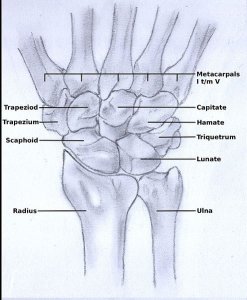Carpal Tunnel Syndrome
The most common injury of the wrist is carpal tunnel syndrome (CTS), which is increased pressure on a nerve within the wrist. There are eight carpal wrist bones, a single ligament, nine tendons and a nerve that make up the carpal tunnel, so even a small amount of swelling can put a large amount of pressure on the nerve resulting in pain that can impact daily life of the patient
There are numerous factors that can contribute to CTS such as an injury to the wrist, overuse, arthritis, tumors, obesity, diabetes or hypothyroidism. The first symptoms that are often experienced is numbness and tingling in the thumb, index, middle and radial side of the ring finger.
To best determine the treatment of CTS, an xray will usually be taken. If symptoms are more severe, surgery is necessary to make room for the nerve inside of the carpal tunnel.
Scaphoid Fractures
Within the carpal tunnel the single bone that sustains the most injuries is the scaphoid. The scaphoid is best described as a ball in the wrist joint that allows the hinge-like movement of the wrist. The placement of this bone does not allow adequate blood flow, so any injury such as a fracture typically results in surgery. Without enough blood, the bone is unable to heal on its own.
If the scaphoid injury is left untreated, the patient can develop a loss of motion in the wrist and arthritis. Treatment of a scaphoid fracture may include a cast to immobilize the wrist until the injury heals or a screw may be inserted to realign the bone, in addition to wearing a cast for 6-12 weeks.




